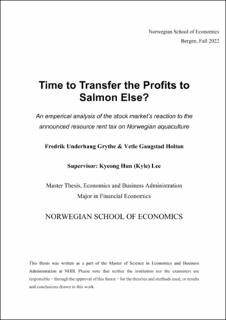Time to Transfer the Profits to Salmon Else? An emperical analysis of the stock market’s reaction to the announced resource rent tax on Norwegian aquaculture
Master thesis
Permanent lenke
https://hdl.handle.net/11250/3050569Utgivelsesdato
2022Metadata
Vis full innførselSamlinger
- Master Thesis [4372]
Sammendrag
On the 28thof September 2022, the Norwegian Government announced a proposal for resource
rent taxation on the Norwegian fish farming industry. This thesis examines the Norwegian
stock market's reactions to the proposal to raise awareness of its financial implications. These
implications are answered using the event study methodology described byMacKinlay (1997).
The sample consists of five salmon farming companies listed on the Oslo Stock Exchange,
where all the companies are directly impacted by the implementation of resource rent tax.
The primary objective is to identify if the resource rent tax announcement leads to a cumulative
abnormal return significantly different from zero on the event day and in our main event
window [-5, 5]. In addition, the thesis will investigate if there are signs of information leakage
prior to the announcement and examine if there are any post-event price drifts. We will also
attempt to determine how operational and financial flexibility affect the stock market's
response.
The analysis finds a cumulative abnormal return of -27.60% on the event day. The steep cliff
shows that the market instantly changes the fish farming companies' valuation following
receiving the information about the resource rent tax. In the main event window [-5, 5], we
find a cumulative abnormal return of -44.03%. This cumulative abnormal return is distributed
between the pre-event and post-event window. In the pre-event window [-5, -l], we find a
cumulative abnormal return of -8.47%. Our findings could indicate information leakage prior
to the event, but that would only be speculation. However, in the post-event window [ l , 5],
we find a cumulative abnormal return of -7.96%, and we notice a price drift after the 28th of
September 2022. All cumulative abnormal returns mentioned above are calculated using the
market model and are significantly different from zero on all conventional levels.
To measure operational flexibility, we have used harvested volume in Norway as a ratio of the
total harvested volume. We identified a trend towards a higher concentration of harvested
volume in Norway, resulting in a lower cumulative abnormal return. Further, to measure
financial flexibility, we use a net debt to assets ratio. Also, here, we identified a trend towards
a higher net debt to assets ratio resulting in a lower cumulative abnormal return. However, the
results should be interpreted with caution due to the small sample size in our research.
